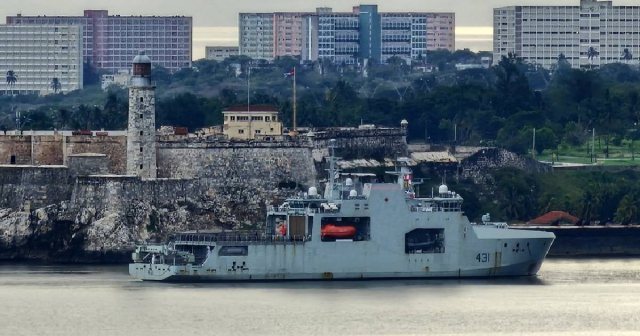Some Cubans from the United States who were on a boat near Miami spotted the Russian war fleet that spent five days in the port of Havana on an official visit.
"Arriving in Miami, gentlemen, arriving in Miami," said a man in one of the videos shared in the Facebook group "Alamar Miami."
The recording shows the oil tanker from the Pashin fleet and the frigate Admiral Gorshkov when they were 22 miles from Miami.
The naval detachment, also comprising the salvage tug Nikolai Chiker (SB-131) and the Kazan nuclear-powered submarine, left Cuba on Monday, June 17th.
According to El Nuevo Herald, a federal official told the editorial McClatchy and the Miami Herald that the three warships set sail for the Caribbean while being closely watched by the U.S. Navy. It is expected that they will make a stop in Venezuela.
On the other hand, the nuclear submarine began its journey back to the northern Atlantic and was followed by American and Canadian warships, including destroyers and coast guard vessels, as it sailed off the coast of Florida in international waters.
During the naval squadron's stay in Havana, Díaz-Canel visited the frigate and the submarine and spent time with the Russian officers, describing it as an "impressive and pleasant afternoon."
Many Cubans also stood in long lines to board the frigate, thanks to the option offered by the Moscow embassy. For the population, immersed in a serious crisis, it was a unique experience and curious onlookers came to admire the ships and take photos and videos with the Russian sailors.
Internationally, the Russian war fleet in Cuba has sparked various reactions in a scenario marked by the war in Ukraine, which has revived tensions between Russia and the United States.
Moscow said there was no reason for any country, including the United States, to worry, and stated that such exercises are a common practice.
The United States Department of Defense also expressed a similar view, stating that the Russian naval detachment in Havana did not pose a direct threat to the United States.
However, the White House deployed several warships (two destroyers and a Coast Guard ship) and a submarine reconnaissance aircraft to track the course of the Russian flotilla before its arrival in the Cuban capital.
The day after its arrival, on June 13, the United States Southern Command reported the arrival of the nuclear submarine USS Helena at Guantanamo Bay, in a move described as a "routine port visit."
What do you think?
COMMENTFiled under:
